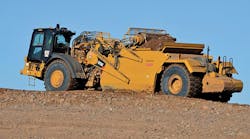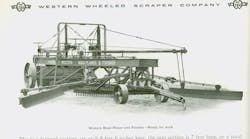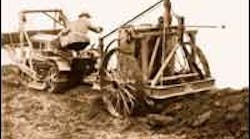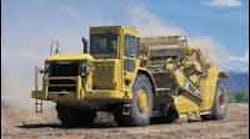As developers seek methods for reducing the impacts of their projects on the natural environment, the contractors who work for them are doing the same thing. In Mount Vernon, Wash., contractor Plats Plus Inc. chose to employ a low-impact tractor-scraper combination for the site preparation work on a 40-acre housing development.
The developer, David Alan Development LLC of Mill Creek, Wash., took the opportunity to make this project the first low-impact development in Mount Vernon, said Don Poe of Sustainable Development Services, who worked with the developer on the low-impact elements of the project plan. Semrau Engineering & Surveying, of Mount Vernon, provided the engineering for the 87-home gated subdivision.
Low-impact development is a relatively new strategy designed to address the challenges posed by the additional stormwater runoff created when a property is developed.
The problem, says the Washington State Department of Ecology, is that "virtually all the state's urban creeks, streams and rivers are harmed by stormwater pollution. In general, untreated stormwater is not safe for people to drink and is not recommended for swimming. It can contain toxic metals, organic compounds, bacteria, and viruses. Polluted stormwater can close beaches for swimming and clam digging. Stormwater can also trigger toxic algae blooms.
"Under the federal Clean Water Act, local governments are required to have discharge permits for their storm drain systems. These permits have been required for Clark, King, Pierce, and Snohomish counties and the cities of Seattle and Tacoma for more than 10 years. Under recent EPA rules, an additional 101 cities and 13 counties across the state are required for the first time to have permits for their storm drain systems. EPA delegates these rules to the states to administer."
According to an organization called The Low Impact Development Center, "Low Impact Development is a new, comprehensive land planning and engineering design approach with a goal of maintaining and enhancing the pre-development hydrologic regime of urban and developing watersheds. This design approach incorporates strategic planning with micro-management techniques to achieve superior environmental protection, while allowing for development or infrastructure rehabilitation to occur. This innovative approach can be used to help meet a wide range of Wet Weather Flow control and community development goals."
Examples of innovative, LID projects include, but are not limited to, permeable pavement; bioretention swales, slopes or cells; rain gardens; vegetated roofs; reverse slope sidewalks; various levels of dispersion; and rainwater harvest projects.
Maintaining the TopographyDavid Alan Development incorporated a number of low-impact strategies into its Mount Vernon project.
"We've got 40 acres, with a fish bearing stream down the west side, so we're only building on 18 acres," Poe said. "We did buffers beyond the requirements to disturb as little as we can."
While neighboring subdivisions feature 40-foot-wide lots, the lots here will be 80 feet wide, Poe added. Other LID features will include such items as permeable paving on driveways.
But the effort to minimize the project's impact on the environment actually started with the site work.
"We have a lot of challenges here. It's not an easy site to do," Poe explained. "We're not overgrading the site. We intend to maintain the basic topography that is here."
Plats Plus, based in Marysville, Wash., has the job of preparing the property for houses the built on it — everything from cutting in roads, ponds and swales to pipe work, said Jeff Van Den Top, president of the company.
At 20,000 cubic yards, this is not a particularly big dirt job for Plats Plus, which has handled project up to 250,000 cubic yards. But one important LID aspect of Semrau's design is that no export or import of dirt is required.
"It's not a real heavy dirt show, but it's an interesting one," observed Ken Tyas, site foreman for Plat Plus. "They all are."
To move the dirt at the site, Plats Plus is employing four tractor-scraper combinations. When PB&E visited the site in May, they were constantly in motion moving dirt from one end of the site to the other. Van Den Top said he started using such combos in place of powered scrapers eight years ago.
"The problem in this country with push scrapers is if you get a hill, you're done," he explained. "With these, there's no crashing and banging like the old push scrapers."
Van Den Top also prefers scrapers to the option of using off-road articulated haulers because the scrapers provide faster cycle times.
"The problem with the haulers is, they've got to stop to load and dump. And you need a spread Cat at the end," he said. The scrapers even provide an advantage when they are being top-loaded by an excavator, because they sit lower and don't require the excavator operator to lift a load as high to dump it, he added.
"We've just made a commitment to use bigger iron and do the jobs faster," he said. "We can cut weeks off the schedule."
The other LID advantage of using all-wheel-drive tractors with pull scrapers, Tyas said, is that the eight-wheel tractors have a lighter impact on sensitive ground than other earth movers. And depending on the haul distances on a site, the tractors can double up and pull two "cans" at once, he added.
Two New TractorsPlats Plus owns seven tractor-scraper setups, Van Den Top said. Four of the tractors are Case and three are John Deere. The company owns four 17-cubic-yard capacity Terex 417B pull scrapers and rents six others.
For the Mount Vernon project, Plats Plus took delivery of two new Case IH STX 480 tractors from Farmers Equipment Co. A John Deere 9400 also was operating on the day PB&E visited the site.
Case IH builds six specially designed versions of its Steiger tractor with added durability to handle the demands of dirt-moving applications — four scraper wheeled versions and two scraper QUADTRAC tractors. Designed for use with an ejector-type scraper or a carry-all, special scraper versions of the STX380, STX430, STX480, and STX530 tractors have the following features:
- Heavy-duty axles;
- Heavy-duty, Quick-Attach scraper drawbars;
- Built-in frame weight;
- Differential locks;
- Backup alarm;
- Tow cable;
- Beacon light;
- High-flow, hydraulic pump.
For safety on the construction site, these tractors are ROPS and FOPS certified. A reinforced, rugged chassis handles heavy loads and nonstop cycles. Weights can be added to ballast for the best performance with full scraper pans. The Steiger power train can efficiently pull scrapers at speeds above 4 mph with engine speeds above 1,700 rpm.
Van Den Top said he has been very satisfied with the reliability of the Case tractors, but there is a more aesthetic characteristic he likes as well.
"I love the sound of those Cases when the turbo kicks in," he said with a grin.
Plats Plus started the dirt work for the Mount Vernon project on May 14 and expected to finish it in three to four weeks so the pipe crew could begin its installations. The property should be ready for construction of the homes to begin by October.



